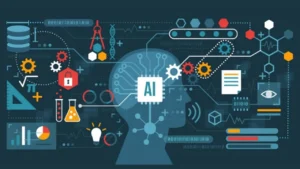AI
Lillienu: AI-Powered Platform for Smarter Decision Making

Lillienu is the most advanced AI, ML, and cloud camping platform that brings digital structures to optimality. As designed to handle maximum traffic data to analyzing nature, it help businesses to come up with accurate quick decisions. Lillienu meets current trends and increasing demand for automation and intelligent systems targeted at non-car businesses by implementing advanced algorithms and technologies needed for large business organization with large customer base. It is mainly concentrated on deriving value from the software from the users’ perspective as well as improving collaborators’ efficiency while deploying decision making processes and proper functioning. Dealing with the customer or dealing with large shipments of data, it provides solutions that enhance performance, minimize expenses, and increase accuracy of decision-making.
Understanding AI-Powered Decision Making
AI integrated decision making refers to using artificial intelligence to make decisions through analysis, pattern recognition and defining subsequent course of action. This has a positive effect on the speed and accuracy of business decision making processes that enable organizations change strategy with speed in responding to changing market conditions. This is improved on by machine learning, a sub category of artificial intelligence since it allows a system to learn from the data it has been fed, make predictions and improve on its decision making process each time. Lillienu goes a step further by including cloud since the program will have to be scalable and accessible. It further integrates these technologies to enable dynamic and data driven decisions making across industries.

Applications of Lillienu in Various Industries
- Healthcare: Enhances diagnoses and treatment planning with advanced data analysis and AI-driven insights.
- Retail: Optimizes inventory management, demand forecasting, and customer personalization for improved sales strategies.
- Finance: Detects fraud, assesses risks, and enhances financial forecasting with accurate, data-driven tools.
- Manufacturing: Streamlines supply chains, improves production efficiency, and reduces waste through predictive analytics.
- Education: Personalizes e-learning experiences and improves institutional efficiency using AI-powered solutions.
Key Features of Lillienu
Lillienu offers a range of features that redefine digital optimization. Its advanced data processing capabilities allow organizations to handle massive datasets efficiently. Integration with existing systems ensures seamless adoption without disrupting current workflows. Real-time analytics provide insights that drive informed decisions, while automation streamlines processes, reducing manual effort. Additionally, its ability to personalize solutions makes it adaptable to various industries. By enhancing system performance through AI algorithms and leveraging cloud computing for storage and accessibility, it creates a robust platform for businesses. These features collectively make Lillienu an invaluable tool for enhancing decision-making, improving efficiency, and achieving sustainable growth.
How Lillienu Optimizes Digital Systems
Lillienu increases efficiency in the process by elimination of repetitive tasks in various digital systems. Using AI algorithms, the computer evaluates and processes data and immediately shows areas of problem and ways to fix them. Third, the cloud solutions that the platform is integrated with guarantee data storage and retrieval as well as scalability. For instance, a retail company might employ it to identify consumer’s behavior in buying patterns and manage the appropriate stock management, or possibly a health care entity may possibly improve the delivery of care through smart health status tracking. By automating routine processes and delivering insights, it improves overall system performance. It transforms digital operations, empowering organizations to focus on innovation and strategy rather than mundane tasks.
Benefits of Using Lillienu
- Increased Efficiency: Automates tasks and streamlines workflows to boost operational performance.
- Cost Reduction: Minimizes manual intervention and resource wastage, leading to significant cost savings.
- Enhanced Decision-Making: Provides accurate, data-driven insights to support informed business decisions.
- Improved User Experience: Personalizes services and delivers faster solutions for superior customer satisfaction.
- Scalability and Adaptability: Scales seamlessly with organizational growth, addressing evolving operational needs effectively.
Integration and Implementation of Lillienu
Integrating Lillienu into existing systems is seamless due to its compatibility with diverse digital platforms. The implementation process involves assessing organizational needs, customizing solutions, and deploying the platform with minimal disruption. Businesses can integrate Lillienu with CRM, ERP, and other enterprise systems to maximize efficiency. Customization options ensure that the platform aligns with unique business requirements. Once implemented, it starts analyzing workflows, identifying inefficiencies, and delivering actionable insights. Organizations also receive ongoing support for updates and system enhancements. This adaptability and ease of integration make it ideal choice for businesses looking to harness the power of AI, ML, and cloud computing.
Security and Reliability
Security and reliability is important for Lillienu. It also includes advanced encryption protocols in a way that all form of information which is sensitive cannot be accessed by anyone else apart from the user. The platform’s architectural design has also integrated AI to not only recognize but also prevent cyber threats in advance. Other tools regarding where data is backed up and recovered add to the reliability; protecting it from events that may occur. On this basis, it secures and provides relevant data storage based on cloud computing by allowing scalable access to the resources. These measures also help to pay attention to the regulations Regarding data protection and also gain the trust of the users.

Read Also: How to protect user data and user’s data privacy?
Future of AI and ML with Lillienu
Based on the current development and analysis, Lillienu is ready to spearhead the next generation of AI and ML adoption. Upcoming trends reveal enhanced promotion of intelligent technologies in the market. Through growth the company adapts to the development of technologies in the future, a factor making Lillienu relevant in future. The purpose of elaborating such platform has its desire on the automation process, scalability, and personalization, which corresponds to the increasing importance of intelligent systems. Some furtherance can be made on the use of more accurate forecasting or the gadgets, or real-time communication applications.
Conclusion
Lillienu is a relatively unseen advancement in the current age making use of artificial intelligence in decision making and digitization. When applied together as AI, ML, and cloud computing merge, it enables the business to make better decisions quicker and more accurately. It is a high value tool across industries due to it flexibility, productivity and adaptability that fosters innovation and efficiency. Used for improving the overall user experience to managing work processes, it changes the way that organizations prevail in the new world.. As businesses continue to embrace AI-driven solutions, it stands out as a pioneering platform that combines cutting-edge technology with practical applications. Embracing it means investing in the future of smarter, data-driven decision-making.
-

 BIOGRAPHY7 months ago
BIOGRAPHY7 months agoBehind the Scenes with Sandra Orlow: An Exclusive Interview
-

 HOME1 year ago
HOME1 year agoDiscovering Insights: A Deep Dive into the //vital-mag.net blog
-

 HOME1 year ago
HOME1 year agoSifangds in Action: Real-Life Applications and Success Stories
-

 BIOGRAPHY1 year ago
BIOGRAPHY1 year agoThe Woman Behind the Comedian: Meet Andrew Santino Wife




























